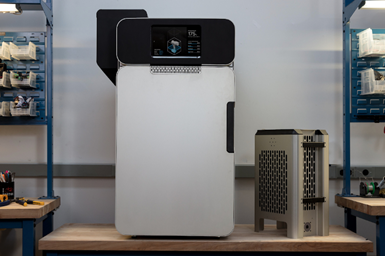Formlabs’ Fuse 1 Benchtop Industrial SLS Printer Simplifies Workflow
The Fuse 1 features Surface Armor technology, a 70% powder refresh rate and a versatile Nylon 12 powder to deliver an affordable, simplified industrial 3D printing.

Formlabs’ Fuse 1 SLS printer is designed to expand access to production-ready 3D printing.
Formlabs’ Fuse 1 is a benchtop industrial selective laser sintering (SLS) 3D printer designed to enable engineers, designers and manufacturers at all levels to rethink product development, hybrid manufacturing and end-use production. Utilizing the company’s Fuse Sift (a postprocessing system for the Fuse 1) and Nylon 12 Powder (Formlabs’ first powder material for Fuse 1) gives users a straightforward end-to-end SLS workflow.
According to the company, the Fuse 1 features powerful Surface Armor technology, a 70% powder refresh rate and a versatile Nylon 12 powder to deliver a simplified industrial 3D printing workflow at a fraction of the cost of traditional industrial SLS printers.
SLS technology is known for its ability to print strong, functional prototypes and end-use parts. The company says the Fuse 1 is designed to make SLS 3D printing affordable and easy to use for all companies — from startups to big manufacturers — so they can benefit from the design freedom and high productivity SLS 3D printing provides. Formlabs’ complete end-to-end SLS printing system takes the guesswork and challenges out of creating strong, functional parts, all while minimizing costs, freeing many organizations from their reliance on expensive and slow external solutions, the company says.
The Fuse 1 enables users to take control of their entire product development process, from iterating on the first concept design to manufacturing ready-to-use products in production-ready nylon. Fuse 1 features include a modular build chamber that enables continuous printing and reduces downtime, and Surface Armor technology that creates semi-sintered shell to protect the surface of the part as it prints. It also has the capability to print with up to 70% recycled powder; and has a material refresh rate (the minimum ratio of fresh powder required to print), of 30% for minimal material waste.
Related Content
-
3D Printing with Plastic Pellets – What You Need to Know
A few 3D printers today are capable of working directly with resin pellets for feedstock. That brings extreme flexibility in material options, but also requires greater knowledge of how to best process any given resin. Here’s how FGF machine maker JuggerBot 3D addresses both the printing technology and the process know-how.
-
Aircraft Ducts 3D Printed in Composite Instead of Metal: The Cool Parts Show #68
Eaton’s new reinforced PEKK, tailored to aircraft applications, provides a cheaper and faster way to make ducts compared to formed aluminum.
-
6 Trends in Additive Manufacturing Technology at IMTS 2024
3D printers are getting bigger, faster and smarter. But don’t overlook the other equipment that the AM workflow requires, nor the value of finding the right supplier.










